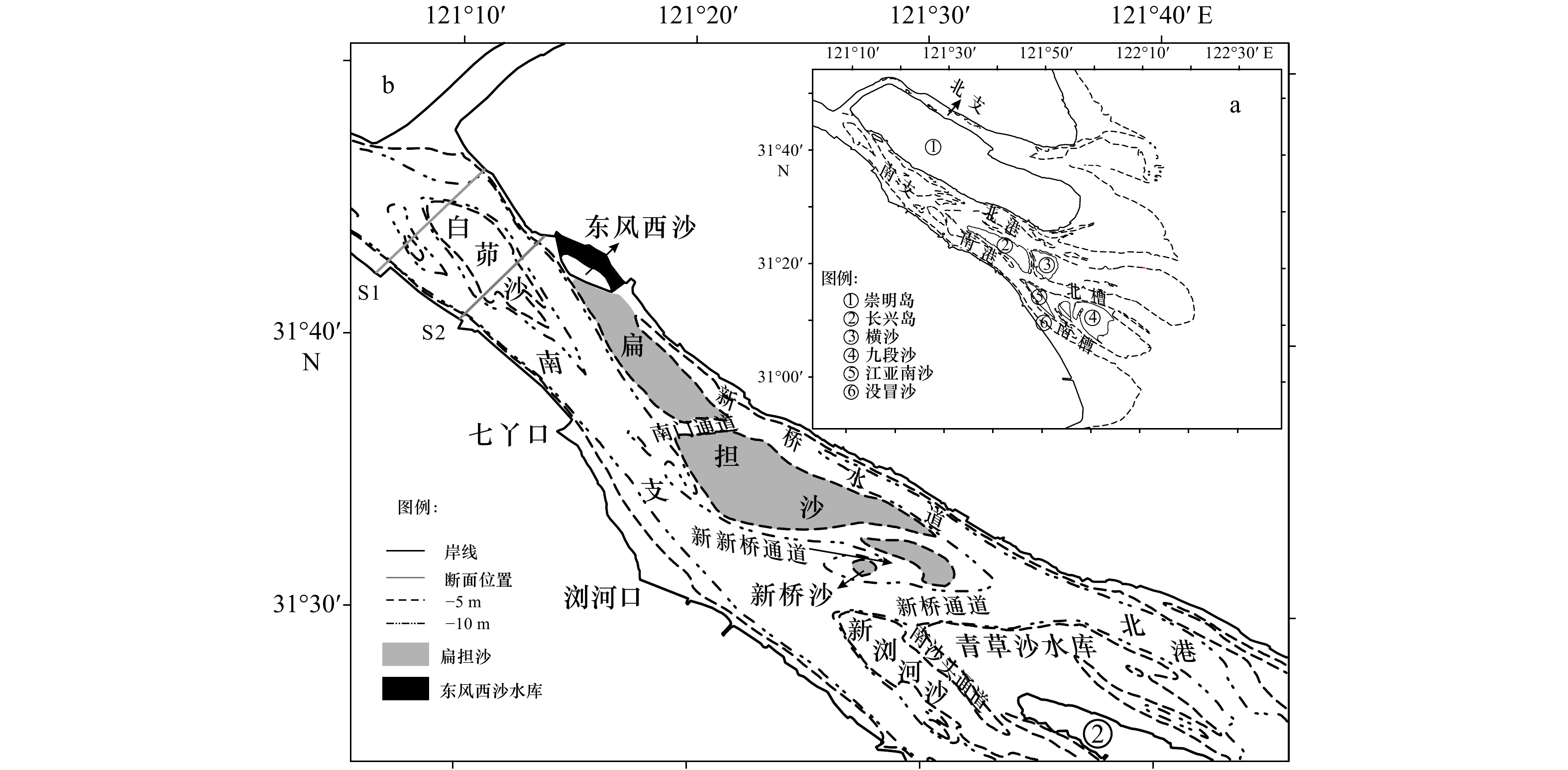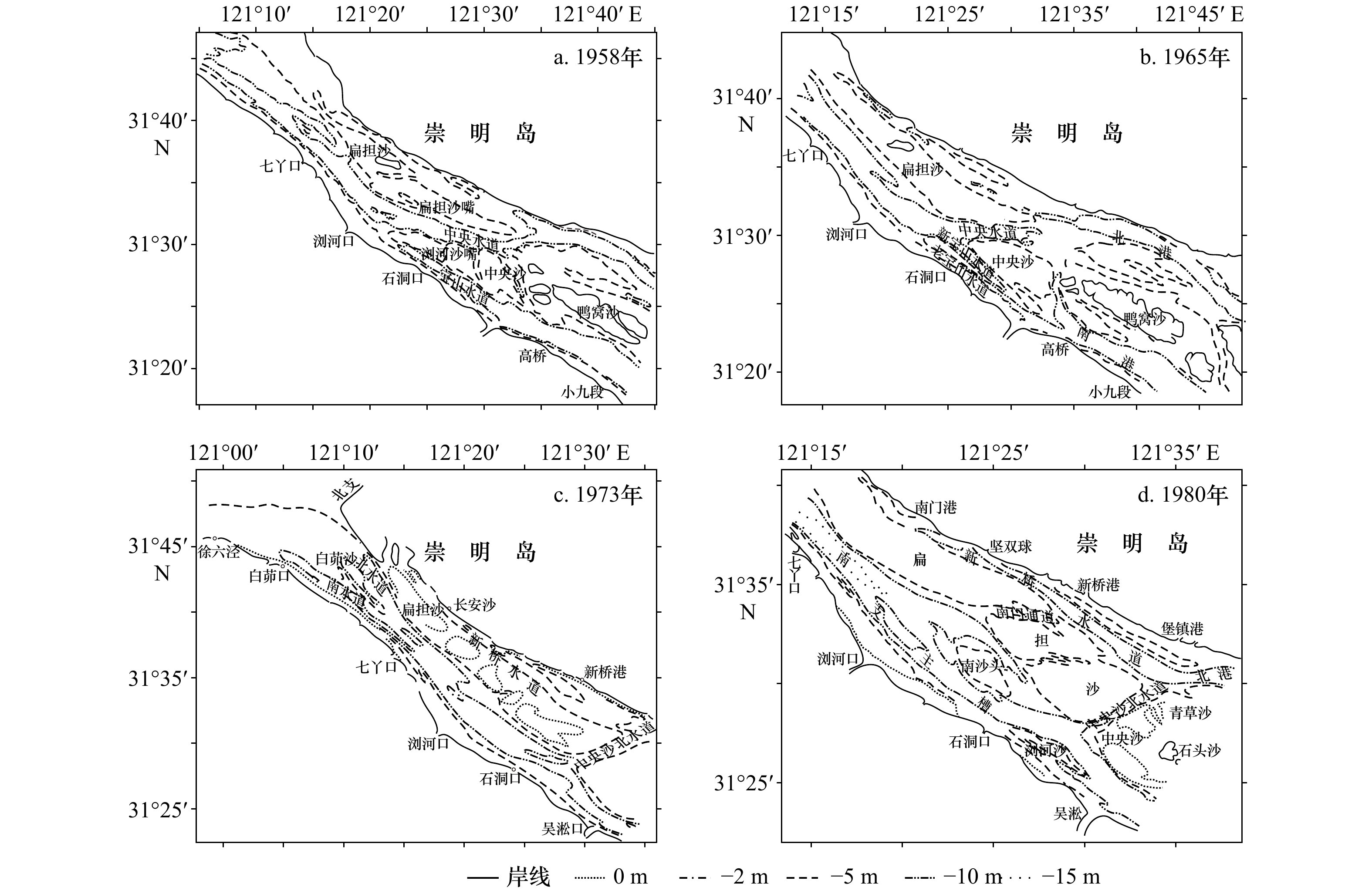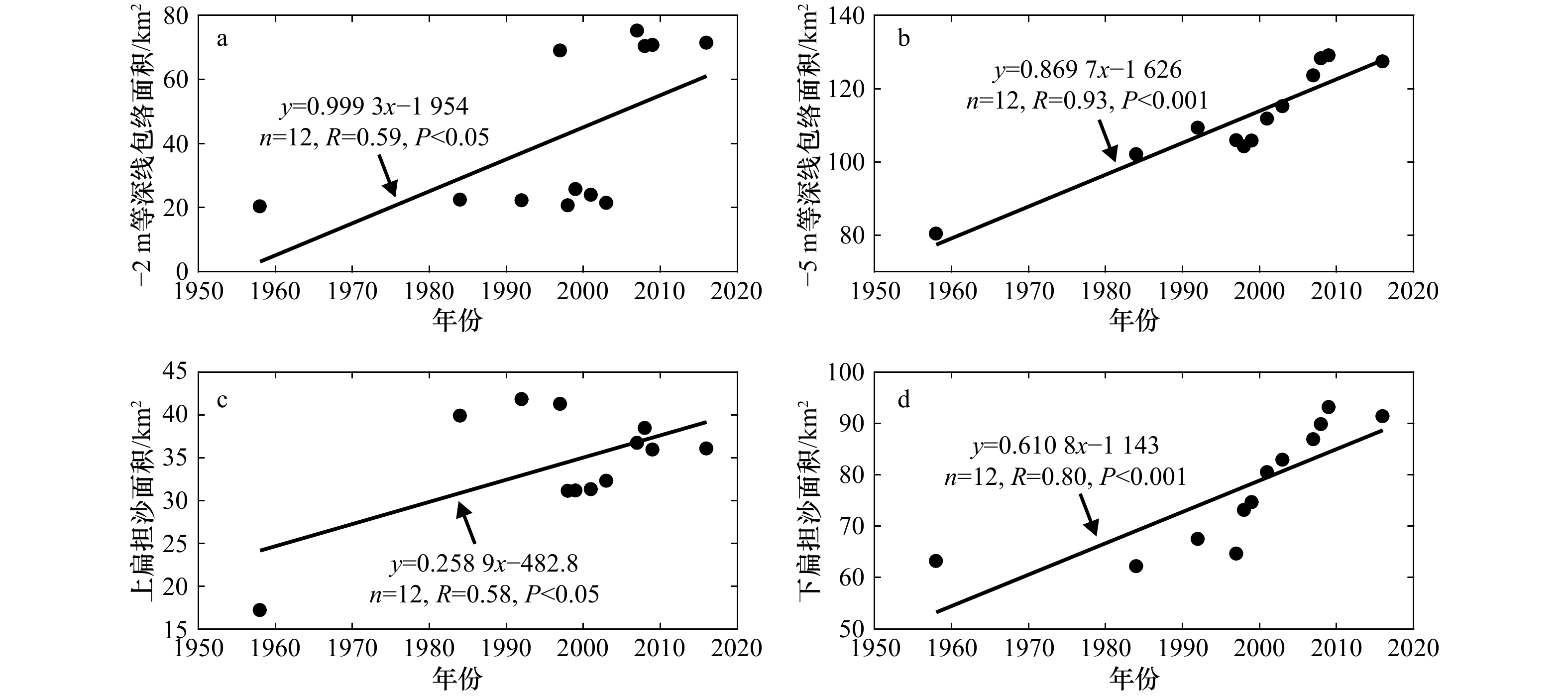| [1] |
Dyer K R, Christie M C, Wright E W. The classification of intertidal mudflats[J]. Continental Shelf Research, 2000, 20(10/11): 1039−1060.
|
| [2] |
Knaapen M A F. Sandbank occurrence on the Dutch continental shelf in the North Sea[J]. Geo-Marine Letters, 2009, 29(1): 17−24. doi: 10.1007/s00367-008-0105-7
|
| [3] |
Kim S G. The evolution of coastal wetland policy in developed countries and Korea[J]. Ocean & Coastal Management, 2010, 53(9): 562−569.
|
| [4] |
Anthony E J, Brunier G, Besset M, et al. Linking rapid erosion of the Mekong River delta to human activities[J]. Scientific Reports, 2015, 5: 14745. doi: 10.1038/srep14745
|
| [5] |
Dai Z J, Liu J T, Wen W. Morphological evolution of the South Passage in the Changjiang (Yangtze River) Estuary, China[J]. Quaternary International, 2015, 380-381: 314−326. doi: 10.1016/j.quaint.2015.01.045
|
| [6] |
Wei W, Mei X F, Dai Z J, et al. Recent morphodynamic evolution of the largest uninhibited island in the Yangtze (Changjiang) Estuary during 1998-2014: influence of the anthropogenic interference[J]. Continental Shelf Research, 2016, 124: 83−94. doi: 10.1016/j.csr.2016.05.011
|
| [7] |
Mei X F, Dai Z J, Wei W, et al. Secular bathymetric variations of the North Channel in the Changjiang (Yangtze) Estuary, China, 1880-2013: causes and effects[J]. Geomorphology, 2018, 303: 30−40. doi: 10.1016/j.geomorph.2017.11.014
|
| [8] |
Kohsiek L H M, Buist H J, Bloks P, et al. Sedimentary processes on a sandy shoal in a Mesotidal Estuary[M]//Tide-Influenced Sedimentary Environments and Facies. Netherlands: Springer, 1988: 201-214.
|
| [9] |
胡红兵, 程和琴, 胡方西, 等. 长江口第二、三代冲积岛浅滩演变特征分析[J]. 泥沙研究, 2004(6): 57−63. doi: 10.3321/j.issn:0468-155X.2004.06.011Hu Hongbing, Cheng Heqin, Hu Fangxi, et al. Evolution characteristics of the shoals of the second and third generation alluvial islands in the Changjiang Estuary[J]. Journal of Sediment Research, 2004(6): 57−63. doi: 10.3321/j.issn:0468-155X.2004.06.011
|
| [10] |
Syvitski J P M, Kettner A J, Overeem I, et al. Sinking deltas due to human activities[J]. Nature Geoscience, 2009, 2(10): 681−686. doi: 10.1038/ngeo629
|
| [11] |
Wei W, Dai Z J, Mei X F, et al. Shoal morphodynamics of the Changjiang (Yangtze) Estuary: influences from river damming, estuarine hydraulic engineering and reclamation projects[J]. Marine Geology, 2017, 386: 32−43. doi: 10.1016/j.margeo.2017.02.013
|
| [12] |
Gao A, Yang S L, Li G, et al. Long-term morphological evolution of a tidal island as affected by natural factors and human activities, the Yangtze Estuary[J]. Journal of Coastal Research, 2010, 26(1): 123−131.
|
| [13] |
Angamuthu B, Darby S E, Nicholls R J. Impacts of natural and human drivers on the multi-decadal morphological evolution of tidally-influenced deltas[J]. Proceedings of the Royal Society A: Mathematical, Physical and Engineering Sciences, 2018, 474(2219): 20180396. doi: 10.1098/rspa.2018.0396
|
| [14] |
时连强, 李九发, 应铭, 等. 长江口没冒沙演变过程及其对水库工程的响应[J]. 长江流域资源与环境, 2006, 15(4): 458−464. doi: 10.3969/j.issn.1004-8227.2006.04.009Shi Lianqiang, Li Jiufa, Ying Ming, et al. Evolutional process in Meimaosha of the Yangtze River Estuary and its response to reservoir project[J]. Resources and Environment in the Yangtze Basin, 2006, 15(4): 458−464. doi: 10.3969/j.issn.1004-8227.2006.04.009
|
| [15] |
盛皓, 戴志军, 梅雪菲, 等. 长江口青草沙水库前沿河床演变与失稳风险研究[J]. 海洋工程, 2017, 35(2): 105−114.Sheng Hao, Dai Zhijun, Mei Xuefei, et al. Research on evolution and instability risk of the frontal river bed along the Qingcaosha Reservoir, Changjiang Estuary[J]. The Ocean Engineering, 2017, 35(2): 105−114.
|
| [16] |
谢华亮, 戴志军, 左书华, 等. 1959−2013年长江河口南槽动力地貌演变过程[J]. 海洋工程, 2015, 33(5): 51−59.Xie Hualiang, Dai Zhijun, Zuo Shuhua, et al. Morphodynamic processes of the south passage of the Yangtze Estuary (1959−2013)[J]. The Ocean Engineering, 2015, 33(5): 51−59.
|
| [17] |
茅志昌, 虞志英, 徐海根. 上海潮滩研究[M]. 上海: 华东师范大学出版社, 2014.Mao Zhichang, Yu Zhiying, Xu Haigen. Research on Shanghai Tidal Flat[M]. Shanghai: East China Normal University Press, 2014.
|
| [18] |
陈吉余. 中国河口海岸研究与实践[M]. 北京: 高等教育出版社, 2007.Chen Jiyu. Estuarine and Coastal Research and Practice in China[M]. Beijing: Higher Education Press, 2007.
|
| [19] |
恽才兴. 长江河口近期演变基本规律[M]. 北京: 海洋出版社, 2004.Yun Caixing. Recent Developments of the Changjiang Estuary[M]. Beijing: China Ocean Press, 2004.
|
| [20] |
郭建强. 长江河口外沙里泓地形的形成演变及其在河口整治开发中的作用[D]. 上海: 华东师范大学, 2008.Guo Jianqiang. The formative processes and application in estuarine regulation and exploiture of out-bar and inner-stream topographty in Changjiang Estuary[D]. Shanghai: East China Normal University, 2008.
|
| [21] |
Dai Z J, Liu J T, Wei W, et al. Detection of the Three Gorges Dam influence on the Changjiang (Yangtze River) submerged delta[J]. Scientific Reports, 2015, 4: 6600. doi: 10.1038/srep06600
|
| [22] |
Yang S L, Milliman J D, Li P, et al. 50, 000 dams later: erosion of the Yangtze River and its delta[J]. Global and Planetary Change, 2011, 75(1/2): 14−20.
|
| [23] |
Dai Z J, Mei X F, Darby S E, et al. Fluvial sediment transfer in the Changjiang (Yangtze) river-estuary depositional system[J]. Journal of Hydrology, 2018, 566: 719−734. doi: 10.1016/j.jhydrol.2018.09.019
|
| [24] |
夏云峰, 曹民雄, 陈雄波. 长江下游三沙(福姜沙、通州沙、白茆沙)水道演变分析及深水航道整治设想[J]. 泥沙研究, 2001(3): 57−61. doi: 10.3321/j.issn:0468-155X.2001.03.010Xia Yunfeng, Cao Mingxiong, Chen Xiongbo. Formation analysis and regulation plan for dredging channel of the three sand shoals (Fujiang Sand Shoal, Tongzhou Sand Shoal and Baimao Sand Shoal) on the lower Yangtze River[J]. Journal of Sediment Research, 2001(3): 57−61. doi: 10.3321/j.issn:0468-155X.2001.03.010
|
| [25] |
刘怀汉, 袁达全, 裴金林, 等. 长江下游白茆沙水道航道整治对策[J]. 水运工程, 2013(S1): 165−172.Liu Huaihan, Yuan Daquan, Pei Jinlin, et al. Waterway regulation countermeasures of Baimaosha waterway in the lower reach of the Yangtze River[J]. Port & Waterway Engineering, 2013(S1): 165−172.
|
| [26] |
王永红. 长江河口涨潮槽的形成机理与动力沉积特征[D]. 上海: 华东师范大学, 2003.Wang Yonghong. Reformation mechanism and features of dynamic sediment in flood channels of the Changjiang Estuary[D]. Shanghai: East China Normal University, 2003.
|
| [27] |
徐骏, 王珏. 长江口白茆沙汊道段近期河道演变分析[J]. 水利科技与经济, 2015, 21(11): 87−90. doi: 10.3969/j.issn.1006-7175.2015.11.030Xu Jun, Wang Jue. Analysis on recent evolution of Baimaosha branch of Yangtze River Estuary[J]. Water Conservancy Science and Technology and Economy, 2015, 21(11): 87−90. doi: 10.3969/j.issn.1006-7175.2015.11.030
|
| [28] |
王永红, 沈焕庭, 李广雪, 等. 长江口南支涨潮槽新桥水道冲淤变化的定量计算[J]. 海洋学报, 2005, 27(5): 145−150.Wang Yonghong, Shen Huanting, Li Guangxue, et al. Calculation of the amount of siltation and erosion in the Xinqiao Channel of the South Branch of the Changjiang Estuary in China[J]. Haiyang Xuebao, 2005, 27(5): 145−150.
|
| [29] |
郭兴杰. 长江口北港河势演变及稳定性分析[D]. 上海: 华东师范大学, 2015.Guo Xingjie. Channel morphology processes and stability assessment of the North Channel of Yangtze Estuary[D]. Shanghai: East China Normal University, 2015.
|
| [30] |
吴焱. 长江口南北港分流口河段近期河势变化及对区域重大整治工程的影响[J]. 水运工程, 2017(7): 136−140. doi: 10.3969/j.issn.1002-4972.2017.07.027Wu Yan. Evolution of ditributary reach of south and north channels in the Yangtze Estuary and influence on surrounding regulation projects[J]. Port & Waterway Engineering, 2017(7): 136−140. doi: 10.3969/j.issn.1002-4972.2017.07.027
|
| [31] |
关许为, 刘晓敏. 东风西沙水库工程施工期主要风险因素及对策探析[J]. 水利科技, 2012(4): 30−33.Guan Xuwei, Liu Xiaomin. Analysis of main risk factors and countermeasures during construction of Dongfengxisha Reservoir[J]. Hydraulic Science and Technology, 2012(4): 30−33.
|
| [32] |
胡波, 朱慧峰. 东风西沙水源地水质监测与评价[J]. 净水技术, 2016, 35(4): 58−62, 116. doi: 10.3969/j.issn.1009-0177.2016.04.009Hu Bo, Zhu Huifeng. Monitoring and assessment of raw water quality in water source of Dongfengxisha reservoir[J]. Water Purification Technology, 2016, 35(4): 58−62, 116. doi: 10.3969/j.issn.1009-0177.2016.04.009
|





 下载:
下载:














